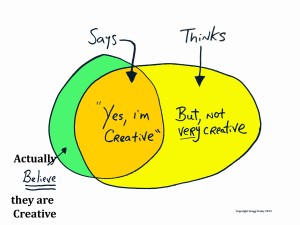![beliefsm2]() Build Innovation From The Ground Up
Build Innovation From The Ground Up
Creative Thinking Can Be Trained
Train Creativity First, Innovation Next
It’s mind numbing all the literature I read about innovation. I’m also a bit weary of chasing or developing the latest, greatest, and most sophisticated tool for ideation. Frameworks are fascinating, but have mercy, it’s overwhelming.
I think I need the mental equivalent of a shot of wheatgrass. I’m getting back to basics.
My new message about innovation is — get back to basics first — and that means the spark of it all, creativity. Yes, I’m an innovation writer, trainer, and consultant, AND, without a creative culture you’re building innovation on a mound of sand.
With creativity activated, facilitators like me help others innovate, using advanced frameworks and tools. But without creative belief and culture, advanced tools are likely to fail. If you, and/or your team, don’t have an organic, natural access to creative thinking, tools like Agile and Design Thinking are running on empty.
It’s not creativity AND innovation. Creativity IS Innovation.
I’ve been imbued in innovation work for nearly 30 years now. Beyond real world projects, I’ve studied the literature, theory, frameworks, strategy, thinking tools, facilitation, assessments, research, project management, team dynamics, and even improvisation. It’s all useful, but you can drown trying to make it useful in projects. So where do you start?
I nearly forget that for some young professionals, innovation is an entirely new challenge. It’s a daunting mountain to climb. Old geezers can also be stymied by challenges? I’m often asked what’s the most essential key to innovation? What’s the “one thing”? That’s a hard question to answer, because, like with all that is complex, it’s never just one thing. With innovation, it’s many things, and all at the same time.
But if there is one thing, it’s creativity. Deliberate, realized, built-into-projects, creativity.
Let’s talk about creativity.
Creativity is widely misunderstood.
First of all creativity is best defined as novelty that’s useful. Notice the “useful” word. That implies implementation doesn’t it? How can an idea be useful if it’s not in play? I suppose if an idea is potentially useful it can be deemed creative without actually implementing. That ambiguity is why we have the innovation word.
Innovation is a more specific “novelty that’s useful,” implying a more measurable, definitive, implemented, result. Innovation, according to the dictionary, is a “new method, idea, or product.” In my view, that definition is another way to say “novelty that’s useful.” Creativity and innovation are two labels for the same human activity: solving problems.
I’m exploring definitions because, however you define it, innovation doesn’t happen without creative thinking. We all want innovation. Useful new things improve lives and organizations. What we tend to resist are the creativity stimulating habits, behaviours and beliefs that help us develop useful new things.
Let’s explore what creativity is NOT.
Creativity is not merely self-expression, it’s focused self-expression, with a result or output.
Creativity is widely thought of as a touchy-feely thing, and, fair enough, it’s pretty close to the essence of humanity. But don’t let that spirit fool you, creativity at its heart, is closer to survival than it is to la la kumbaya. It’s how the human race became successful versus more powerful, faster, animals. It’s not a nice to have. Ignore it at your peril.
Creativity is not artistic talent, but artistic talent, and artsy tools and mindsets, are useful in highly divergent creative problem solving.
Creativity does not require a high IQ, but a high IQ, and domain knowledge, are highly useful in creative problem solving. That said, average people create amazing things every day. An average IQ is no excuse for not creating. Persistence often wins.
Creativity can be trained, and in many different ways. Enhanced self-expression can be unleashed. People can be trained in creative thinking tools, creative behaviours, and structured creative problem solving. And yes, that includes brainstorming, but more importantly, problem framing. It does take work, but anyone (or group) can improve their creative effectiveness.
What Happens to Creativity at Work?
It’s the old 80/20 rule. In my experience it’s the smaller group that gets creativity right and achieves big results. The 80 percent muddle along.
There are talented people who are naturally creative. They bring creativity to their work, they express it, and even if they never think about it, it shows up, and delivers. Their creative thinking solves complex problems. It stands to reason that better access to creative thinking means more problems solved, more solutions, and more innovation. When a culture supports creative self-expression they are setting up the basic fundamentals for innovation. Let’s call these lovely talented people and organizations the 20 percent of Realized Creatives.
There are other talented people out there who have lost touch with their creativity. They’ve been brow-beaten into not expressing it. This brow beating happens early and often (for more on this, see Sir Ken Robinson). Many organizational cultures are toxic to creativity (there is a continuum) and when that happens, guess what? Creativity is not well applied to complex problems, great ideas are not developed, problems are not solved, and solutions are not delivered. Let’s call that sad lot the 80 percent of Unrealized Creatives.
Cultivated Creativity Accelerates Innovation
I believe in innovation methods and frameworks, I teach them, I use them. But they work best in the fertile soil of encouraged — and trained — creativity. Growing a creative culture starts with training in creative behaviours and in structured Creative Problem Solving. Innovation training should come AFTER creativity training and when creative culture principles are put in place.
 Build Innovation From The Ground Up
Build Innovation From The Ground Up